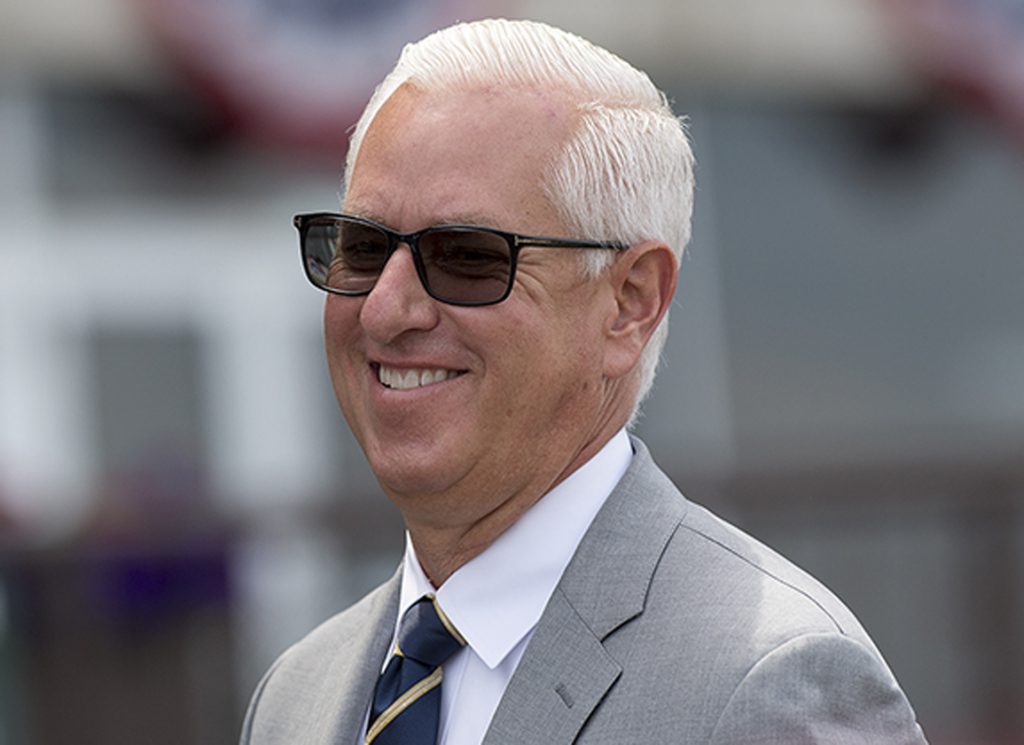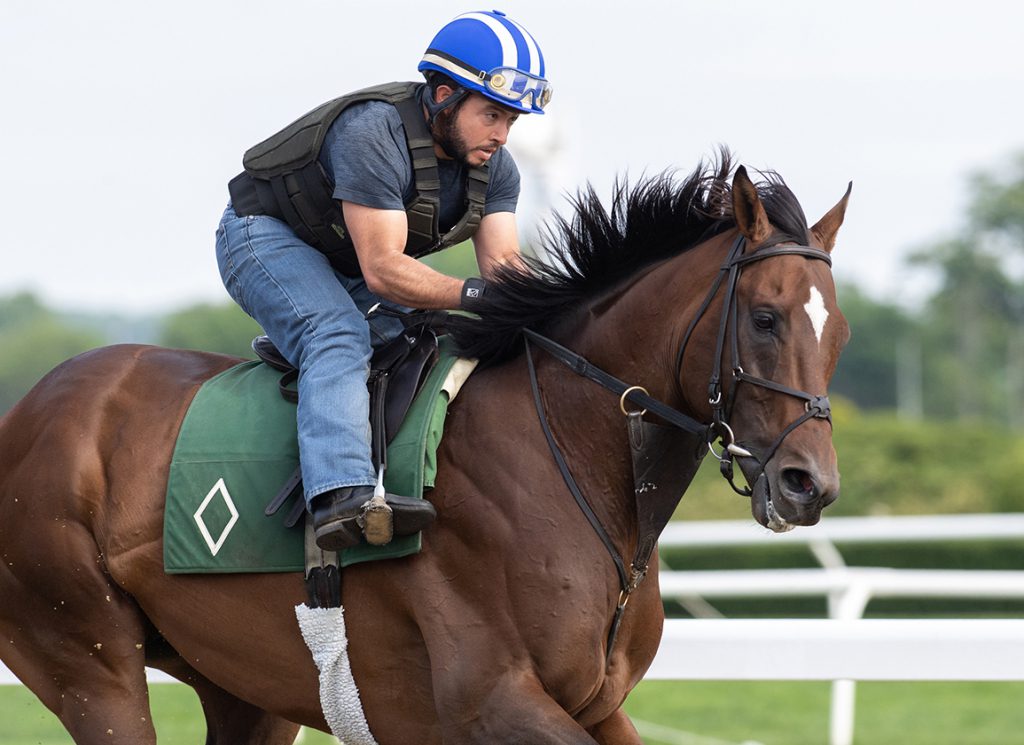SARATOGA SPRINGS, N.Y–Nothing new at old Saratoga this summer. As has been the case for many decades, most of racing's stars will be in town for America's most important Thoroughbred meet of the year.
The first race of the 40 days of the 155th season opens at 1:10 p.m. Thursday with a 10-race program at Saratoga Race Course. By the time the meeting reaches its conclusion on Labor Day, Sept. 4, over 400 races, including 71 stakes worth $20.8 million, will have been run. The traditional opening-day feature is the $175,000 GIII Schuylerville S. for 2-year-old fillies.
Godolphin's Cody's Wish (Curlin), quite likely the most popular horse in the country, leads the deep lineup of standouts expected to compete at Saratoga this summer. That group includes 2022 Eclipse Award winners Forte (Violence), Nest (Curlin), Elite Power (Curlin) and Goodnight Olive (Ghostzapper), all of whom won over the track during their championship seasons. Unbeaten Maple Leaf Mel (Cross Traffic) is on course for the GI Test on the Whitney Day program on Aug. 5.
Todd Pletcher, the 14-time leading trainer at Saratoga, said that Forte will prep for the GI Travers in the GII Jim Dandy on July 29, but the decision has not been made on whether Tapit Trice (Tapit) will run in the GI Haskell on July 23 at Monmouth Park or the Jim Dandy. He said his grass star Up to the Mark (Not This Time) is likely to run in the GI Arlington Million at Colonial Downs, Suburban S. winner Charge It (Tapit) is a candidate for GI Whitney S. on Aug. 5 and that Far Bridge (English Channel) will follow his Belmont Derby score with a start in the GI Saratoga Derby Invitational of Aug. 5.
Cody's Wish, the winner of six straight and nine of his last 10 starts for Hall of Fame trainer Bill Mott, is on course for the $1 million Whitney. It will be a distance test for GI Met Mile winner; he was third in his lone try at 1 1/8 miles in 2021 at Saratoga.
Three years after the Saratoga season was conducted without fans because of the Covid-19 pandemic and following last year's record-setting summer with remarkable weather, this Saratoga meet appears ready to settle into the familiar groove with the focus fixed squarely on the equine talent. It's business as usual at the Spa.
“I think you always think about Saratoga that way,” said Hall of Fame trainer Todd Pletcher. “The COVID year was certainly strange, because it was the first time I'd ever seen empty stalls here because some people were unable to attend. But, aside from that, I think you always come into Saratoga expecting to see the best horses in the Midwest and the East Coast and we'll probably get some California shippers. It's that time of the year when you expect to see top-class horses, running in all the big races.”
This will be the 10th season that Jason Fitch and his brothers Adam and Patrick, have operated Kings Tavern, a fixture on Union Avenue across from the main entrances to Saratoga Race Course. Jason Fitch said that in the past few weeks the track has awakened from its annual slumber.
“The vibe is hard to describe. It's because it's kind of like COVID never happened,” he said. “It's like, everything's back to normal. Everybody's happy. Everyone's excited.”
Kings has a solid year-round local clientele and Fitch said with some out-of-town track customers already making their first visits of 2023, one season flows into the next.
“It kind of felt like the track ended like yesterday,” he said. “For me, personally, it feels like, just yesterday was Labor Day.”
During the racing season Kings opens early: at 9 a.m. on Saturdays and 10 a.m., Wednesday-Friday and on Sunday.
In recent years, the New York Racing Association has unveiled a series of capital projects on the grounds. Last year, the rebuilt Wilson Chute enabled NYRA to add one-mile dirt races to its lineup. This year, the most notable addition is very important–the backstretch healthcare clinic building–but not something that the average racegoer would be aware of.
Saratoga's patrons will notice a change of admission pricing and the move to an all-access ticket. NYRA announced in March that daily tickets purchased at least 24 hours in advance will cost $7 and the day-of-the-event price is $10. Since 2019, a grandstand ticket cost $7 and clubhouse entry was $10. The new approach will allow all visitors to go into the clubhouse. General admission on Travers Day will be $30, but $25 in advance.
Some of the bigger names in sport will compete early in the meet. In Italian (GB) (Dubawi {Ire}) trained by Chad Brown will go after her second-straight win in the GI Diana Saturday and Clairiere (Curlin) will try to repeat in the GII Shuvee on July 23 against Nest, who will be making her 2023 debut.
Nest showed that she was of championship caliber last summer with GI wins in the Coaching Club American Oaks and the Alabama. Pletcher said that the Shuvee run is intended to set her up for the GI Personal Ensign on Aug. 25.
“We wanted to get started a little earlier,” Pletcher said. “Unfortunately, she got sick when she first came in and we basically missed a month. It took a little while, to get her well enough to get her back into training. Our original plan was to either run at Keeneland or Churchill and then the Ogden Phipps. It's just unfortunate that set us back to the point where she is just now getting ready.”
The Saratoga season features important off-track events, too. The Jockey Club's annual Round Table will be conducted on Thursday, Aug. 3, the National Museum of Racing's Hall of Fame will induct its newest members on Aug. 4 and the Fasig-Tipton Saratoga Sale of select yearlings will take place on Aug. 7-8.
Pletcher and Chad Brown have been the kingpins on the trainer's table for 12 consecutive years and it's a very safe bet that they will be vying for the title once again. Brown has won the last two and five of the last seven. Defending champ Irad Ortiz Jr. has won the jockey's competition four times.
Though the $1.25 million Travers, first run in 1864, is always the marquee race of the season, it could be a crucial test to determine the 3-year-old male title following a spring in which three different horses won the Triple Crown races. That trio, GI Kentucky Derby winner Mage (Good Magic), GI Preakness S. winner National Treasure (Quality Road) and G1 Belmont S. champ Arcangelo (Arrogate), may meet in the Travers on Aug. 26. If that happens, it will be an oddity: just the fourth time in history and first since 2017. Arcangelo is already based at Saratoga and being pointed to the Travers. Hall of Fame trainer Bob Baffert has not announced which horses he will run at Saratoga–in his return to the track after missing 2022 due to a ban imposed by the New York Racing Association–but on Monday did not rule out National Treasure for the Travers. He said that recent Los Alamitos Derby winner Reincarnate (Good Magic) is a Travers possibility.
Mage was given a break following his third-place finish in the Preakness on May 20 and resumed training in June. After his next scheduled breeze Friday at The Thoroughbred Center a decision will be made on whether he will make his next start in the Haskell or the Jim Dandy.
“It's a special moment, for sure,” said Mage's co-owner Ramiro Restrepo. “To have all the classic winners in one spot it's lovely for the fans and lovely for the horse players. Like any athlete or representative of an athlete, you want to run against the best and compete against the best and hopefully put forth a good effort. For ourselves, as a collective, our lifelong dreams have been the Kentucky Derby and the Travers. Our dreams are those two races. It's been an incredible ride to have accomplished one and to have a decent shot to accomplish the second one would be, it's really the stuff of dreams. The Travers is our end-all, be-all. That's what we're focusing on.”
Cody's Wish is a very talented 5-year-old with a distinctive backstory. He is named for Cody Dorman, of Richmond, Kentucky who was born with Wolf-Hirschhorn syndrome. As a result of the syndrome, Dorman uses a wheelchair and communicates with a tablet. They met in 2018 during a Make-A-Wish Foundation visit to Gainsborough Farm. The young foal interacted with Dorman and laid his head on the boy's lap, which led to his naming.
Mott's always-strong barn is especially heavy with headliners this year with Cody's Wish, Sprint champion Elite Power, and War Like Goddess (English Channel) in the lineup.
Once a seasonal visitor to Saratoga, Mott has a large part of his stable based at Saratoga for most of the warm weather months. He said he looks forward to the meet.
“It's fun. It's exciting to be a trainer here,” he said. “It's fun when there's enthusiasm around. We enjoy it.”
In the late 1950s, Saratogians feared that NYRA, then a new organization, might drop Saratoga, which was far less popular than the meets at Belmont Park and Aqueduct Racetrack. In 1957, the state legislature passed a bill guaranteeing Saratoga a 24-day season without competition at the downstate tracks. By the 1970s, Saratoga's stature had risen again and it is the most significant meeting on the NYRA calendar. Benefitting from warm, dry weather last summer, NYRA lost just 16 grass races–compared to 45 in 2021–and registered a record all-sources handle of $878,211,963, a jump of 7.7% from the previous year. Excluding fan-free 2020, NYRA reported its seventh-straight season of one million in paid attendance.
In a well-timed announcement on Monday, the Saratoga County Industrial Development Agency said a new report it commissioned showed that the meet at Saratoga Race Course generates $371 million in economic activity and more than 2,900 jobs in the Capital Region.
The post Saratoga Set for 155th Season of Racing appeared first on TDN | Thoroughbred Daily News | Horse Racing News, Results and Video | Thoroughbred Breeding and Auctions.



